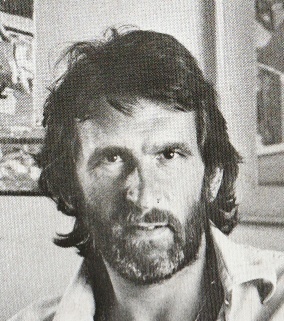
Review of The Art of Self Deception.
Giles Auty
‘An intelligible guide’. Libertarian Books (1977)
Rae West - 27 November 2023Not being sleepy, I browsed one of my libraries, and noticed The Art of Self Deception, thinking it was something to do with Jews. The cover shows three young men in headgear like Keith Richard's, connected by a wooden rod.
This was the era in which the Arts Council in Britain paid for such things, and for 'sculptures' made of bricks. Now I think back, I (or we, in fact) met the Director of the Serpentine Gallery. It's a couple of nice buidlings in Kensington Gardens/ Hyde Park. At about this time, a hat-wearing man calling himself Genesis P Orridge arranged exhibitions of such things as babies' 'soiled' nappies, and used sanitary towels. (I never saw these, and have no idea if they were behind glass or something). Auty's introduction describes all these things.
Giles Auty (born 1934 in Kent where his father 'taught in the local grammar school'. He gives some detail, including being incarcerated by the RAF for reading T.S. Eliot. He seems to have led one of these chaotic early lives expressed personally by suggestions of many and varied occupations which are exciting to describe briefly. In 'the Hemingway/ London/ Miller romantic tradition of the 1950s'. Jack London of course was much earlier. His surname reminds me of a man I met called 'Oughtibridge', taken from the process of throwing animal guts after butchery into the local river in a small town.
Auty said he paints 'comparatively slowly' and one can only guess why he wrote; probably the hope of getting money and/or notoriety. And he writes quite well; perhaps better than he painted.
His publisher seems to have vanished, leaving no name(s) or information. Probably it's a then-typical small publisher. I have no idea how 'Libertarian' it was, or if it would have liked Popper's Open Society or Milton Friedman or Hayek on von Mises, omissive Jews probably still promoted.
They used an IBM golfball—I think the Composer. There's an Index of names, which I'd guess was a money-saving device to economise on the Society of Indexers.
1963 was Auty's formative big year. He went to Madrid and the Prado, perhaps just because it was kept warm. And saw Velasquez' Las Meninas. This style of literature has the problem of conveying emotion, which often becomes a wheedling and repetitive bleat. I won't comment on this (there's a lot) beyond stating that chapter 14, Ten Clichés Examined goes through the prefab protestations given by uninterested newbies. Auty shows he doesn't know the source of "I know what I like" (Zuleika Dobson) and says things about photography which would seem to rule out the use of his cover photo. He counters "You have to wait 100 years" with an account of Renoir's life. He agrees with people who say "I wouldn't want it on my wall"—he'd rather someone would buy it!
Auty (in chapter 15. The Bitter Harvest however does have a theory on how this distressing situation occurred. Though it's not his own theory: he summarises Eva Cockroft (June 1974):–
Art without subject matter can hardly make political or social comment. By strongly promoting such art as the true, world art 'of our time' the CIA hoped to create an effective muzzle for a potentially dangerous sector of the community, i.e. artists, visionaries, and possible mass-communicators.”
Auty asks "Who is ultimately responsible?" and answers himself with: "we all are" and "we must involve ourselves".
He doesn't query the capitalised slogan; what America's need actually was, and for which groups; he doesn't ask if atrocity pictures help; he doesn't ask whether in fact artists have ever done anything to help 'humanity'.
My main motivation in skimming this book was to compare Miles Mathis' art criticism of 35 years or so later. Of his many hundreds of papers, his criticisms of visual arts including films/movies and literature overlap into politics, religion (notably Jewishs) and history, including Greek and Roam and earlier.
Mathis I think is by far the better of the two, which leads me to hope that there may be genuine critical progress. Mathis has views on art establishments which include auctions faked for money transfers; the use of subsidies for museums and colleges and journals on art; a good eye for fakes, including of luminaries such as Leonardo da Vinci and Vermeer; a good eye for visual fakery, not just in painting, but photography and film and digital video. Plus solid critiques of Hemingway, London, and Miller (as mentioned specifically by Auty) and many others; and their political ambiences including wars, science frauds, and such people as Churchill, Roosevelt, and Stalin. Mathis in my view is more accurate in the uses to which art is put, looking at portraits, sculptures, and heraldry.
Auty is polite about the media; he says the Sunday Times is 'respected', for example. He seemed totally unaware of the huge frauds of the modern world. Which no doubt helped him in his career.
So Mathis has it by a list of overwhelming points. And even Auty's tile is misleading: these people know what they're doing.
Since writing that, I thought I might search the web for Auty, and found he lived in Australia and died in 2020, having been a journalist on art. He seems to have been a Roman Catholic. R.I.P.
Rae West big-lies.org 27 November 2023